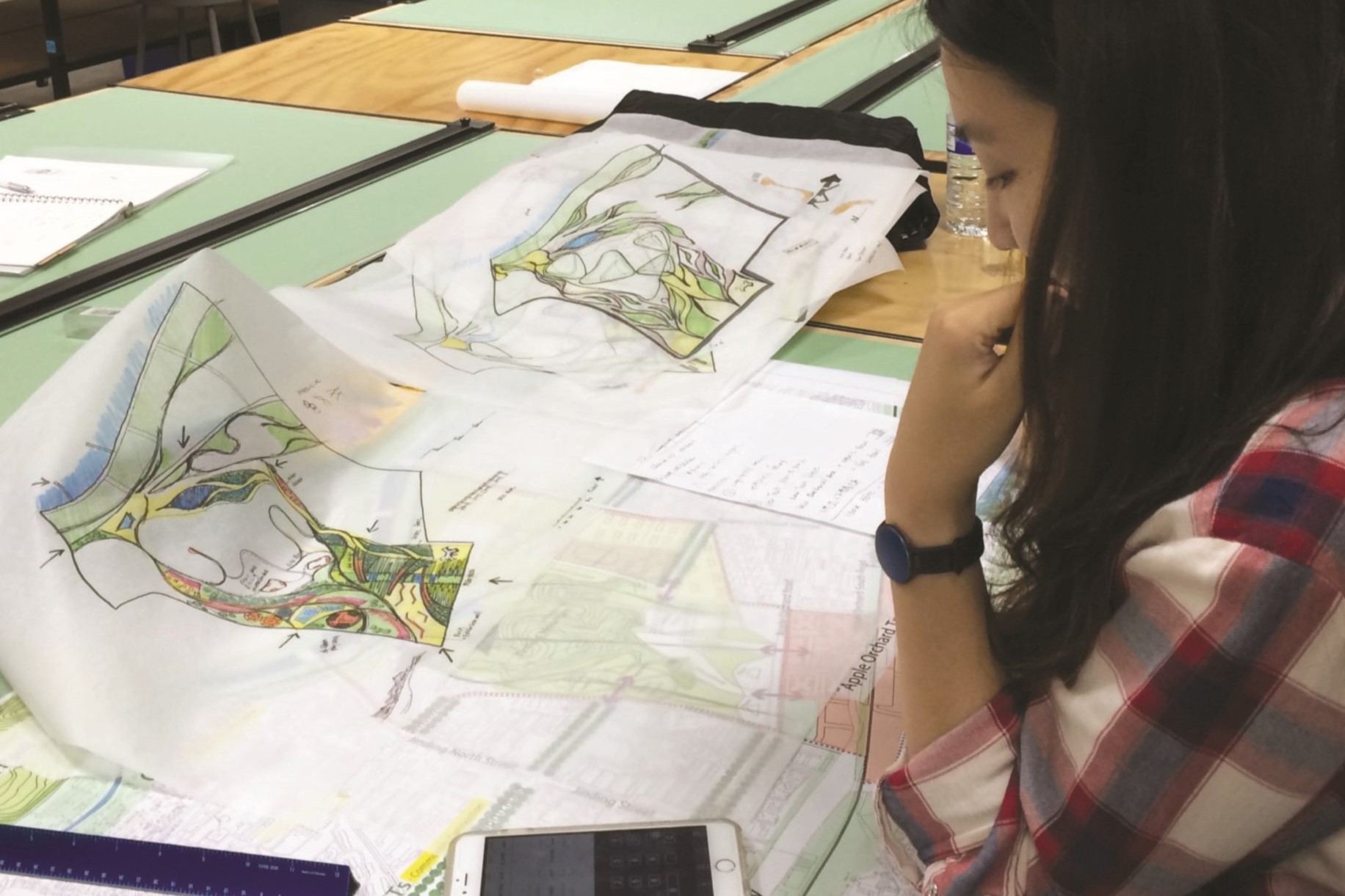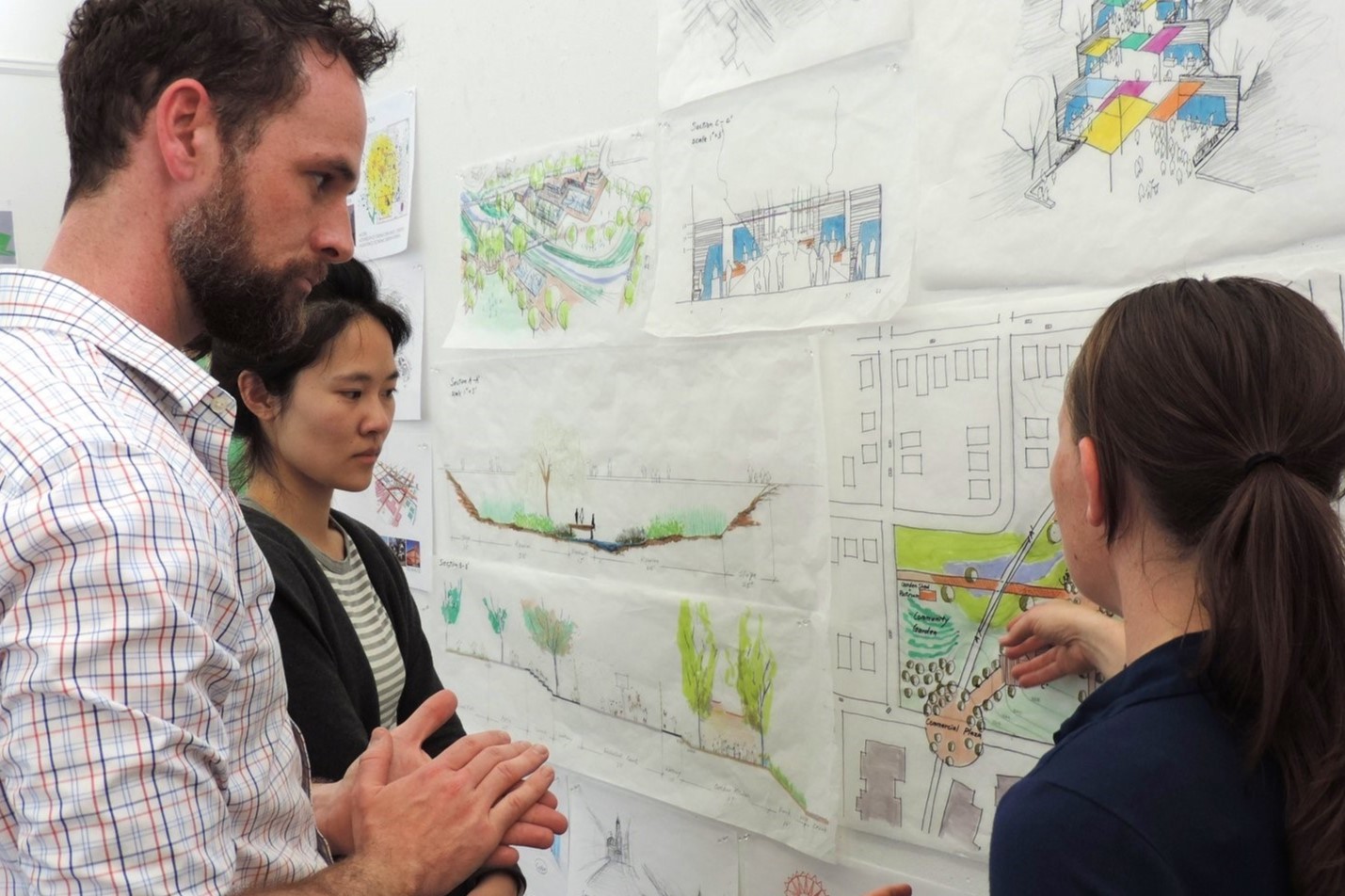Home>diy>Planning & Engineering>Which High School Classes Should I Take To Pursue A Career As A Landscape Architect?


Planning & Engineering
Which High School Classes Should I Take To Pursue A Career As A Landscape Architect?
Modified: January 9, 2024
Discover the essential high school classes to take for a career as a landscape architect, from planning and engineering to design and environmental science. Maximize your potential today!
(Many of the links in this article redirect to a specific reviewed product. Your purchase of these products through affiliate links helps to generate commission for Storables.com, at no extra cost. Learn more)
Introduction
Choosing the right high school classes is crucial for setting a solid foundation for your future career. If you aspire to become a landscape architect, the classes you take during your high school years can greatly impact your success in this field. Landscape architecture is a multidisciplinary profession that combines elements of design, horticulture, environmental science, and engineering. Therefore, a well-rounded education in high school can provide you with the necessary skills and knowledge to pursue a career in landscape architecture.
High school is the perfect time to explore your interests and begin building a strong academic background. By selecting the right classes, you can gain a deeper understanding of the various facets of landscape architecture and develop the skills necessary for success in this field. In this article, we will discuss the importance of high school classes for aspiring landscape architects and explore some essential subjects that you should consider when planning your academic path.
Key Takeaways:
- High school classes such as biology, environmental science, and art & design are crucial for aspiring landscape architects, providing a foundation in ecological systems, sustainable practices, and creative expression.
- Mathematics, computer science, and physical education classes also play a vital role, equipping future landscape architects with essential skills for precision, technology utilization, and a deeper connection with nature.
Importance of High School Classes for a Career in Landscape Architecture
High school is a critical time for laying the groundwork for your future career. When it comes to pursuing a career in landscape architecture, the classes you take during this pivotal period can have a significant impact on your success in the field.
One of the main benefits of taking relevant high school classes is that they provide you with a solid foundation in the fundamental principles and concepts of landscape architecture. These classes can help you develop a comprehensive understanding of the field, its history, theories, and design principles. By studying these subjects early on, you can start honing your skills and fostering a passion for landscape architecture.
Moreover, high school classes in subjects such as biology, environmental science, and geography can provide you with a strong understanding of ecological systems, environmental sustainability, and the natural world. These classes will help you grasp the intricate relationship between human actions and the environment, which is a crucial aspect of landscape architecture. Understanding environmental science can enable you to create sustainable and ecologically responsible designs that harmonize with the natural surroundings.
Another vital aspect of landscape architecture is the design element. High school classes that focus on art, design, and architecture can help you develop your creativity, spatial perception, and visualization skills. These classes can teach you about the principles of aesthetics, composition, color theory, and spatial arrangement, which are essential for creating visually appealing and functional landscapes.
Mathematics and computer science classes are equally important for aspiring landscape architects. Mathematics plays a crucial role in design calculations and measurements, while computer science and technology classes can introduce you to computer-aided design (CAD) software and other digital tools utilized in the industry. Proficiency in these areas will enhance your ability to create detailed designs, generate accurate models, and effectively communicate your ideas to clients and colleagues.
Lastly, strong communication skills are vital for any landscape architect. High school classes in English and communication can help you develop your writing, speaking, and presentation skills. These classes can enable you to effectively convey your design ideas, collaborate with clients and colleagues, and articulate your thoughts and concepts in a professional manner.
By taking relevant high school classes, you will gain a deep understanding of the various aspects of landscape architecture and acquire the skills needed to thrive in this field. Building a strong academic foundation in high school will not only prepare you for your college education but also set you on a path towards a successful career as a landscape architect.
Core High School Classes to Consider
When planning your high school curriculum with the goal of becoming a landscape architect, there are several core classes that you should consider. These classes will provide you with a well-rounded education and help you develop the necessary knowledge and skills for a career in landscape architecture. Here are some essential high school classes to consider:
-
Biology
Biology is a foundational science class that introduces you to the study of living organisms. Understanding biological concepts such as ecosystems, plant life, and ecological systems is crucial for landscape architects. It will help you comprehend the natural environment and its importance in designing sustainable landscapes.
-
Environmental Science
Environmental science explores the interactions between humans and the environment. By taking this class, you will learn about environmental issues, conservation, sustainability, and the impact of human activities on the Earth’s ecosystems. This knowledge is highly valuable for landscape architects, as it will enable you to design environmentally-friendly and sustainable landscapes.
-
Art and Design
Art and design classes provide a solid foundation in aesthetics, creativity, and visual expression. These classes can help you develop your artistic skills, spatial perception, and design thinking. By exploring various artistic mediums and learning about design principles, you will develop an eye for detail and an understanding of how to create visually appealing landscapes.
-
Mathematics
Mathematics is essential for landscape architects as it involves measurements, calculations, and spatial analysis. Classes such as geometry and algebra can help you understand the mathematical concepts and formulas used in landscape design. Proficiency in mathematics will enable you to accurately measure and plan landscapes, ensuring that your designs are functional and precise.
-
Computer Science and Technology
In today’s digital age, computer science and technology play a significant role in landscape architecture. Taking classes in computer science will familiarize you with computer-aided design (CAD) software, modeling tools, and other technology used in the field. Learning these skills will enhance your ability to create realistic and detailed landscape designs.
-
Geography and Geology
Geography and geology classes provide insights into the physical characteristics of the Earth’s surface, including landforms, climate, and natural resources. Understanding these subjects will help you analyze and plan landscapes based on the geographical and geological factors present in a particular area.
-
English and Communication Skills
Strong communication skills are essential for landscape architects, as they often work with clients, stakeholders, and team members. English and communication classes will help you develop effective written and verbal communication skills, enabling you to convey your design ideas and collaborate effectively with others.
-
Architecture and Design Principles
Classes that explore architecture and design principles will provide you with a deeper understanding of the history and theory of design. Studying architectural styles, principles of form and function, and landscape architecture history will give you a solid foundation and inspire your own design approach.
-
History and Social Studies
History and social studies classes broaden your knowledge of cultures, societies, and historical events. These subjects can provide inspiration and help you incorporate cultural and historical references into your landscape designs. Understanding the context of a place can create meaningful and contextually rich landscapes.
-
Physical Education and Outdoor Activities
Physical education and outdoor activities classes can foster a love for nature and the outdoors. Engaging in outdoor activities such as hiking and camping can increase your appreciation for the natural environment and inspire your landscape designs to embrace and enhance the beauty of nature.
By considering these core high school classes, you will lay a strong foundation for your future career in landscape architecture. These classes will provide you with a diverse range of skills and knowledge necessary to excel in this dynamic and creative profession.
Biology
Biology is a fundamental high school science class that delves into the study of living organisms, their structure, function, and relationships. For aspiring landscape architects, taking biology provides a crucial understanding of the natural world and its intricate ecosystems.
Studying biology equips you with the knowledge of plants, animals, and the environment, which are essential components of landscape architecture. Understanding how different species interact with their surroundings, the role of plants in the ecosystem, and the importance of biodiversity can greatly influence your approach to designing sustainable landscapes.
By studying biology, you gain insights into the principles of ecology, including the interdependence and interconnectedness of living organisms. This knowledge will help you design landscapes that are in harmony with the environment, ensuring that your projects are ecologically responsible and considerate of natural processes.
Additionally, biology provides a foundation for understanding the physiological needs and growth patterns of plants. Landscapes often incorporate various plant species, and having knowledge of their biology enables you to select appropriate plant species for specific environments, considering factors such as sun exposure, soil quality, and water requirements.
In biology classes, you will also learn about genetics and evolutionary processes. This knowledge is valuable for understanding the diversity and adaptation of organisms, which can influence your choices when designing landscapes that are resilient to environmental changes. Furthermore, studying the role of pollinators, such as bees and butterflies, can inspire you to create landscapes that support and promote biodiversity.
Biology is not limited to the study of plants and animals; it also covers topics such as ecosystems, biomes, and the impact of human activities on the environment. This broader understanding of the natural world allows you to consider the larger ecological context when designing landscapes, ensuring they fit harmoniously within their surroundings.
Moreover, biology classes often involve hands-on activities, such as laboratory experiments and field studies. These practical experiences provide you with valuable skills in observation, analysis, and data interpretation – skills that are essential for landscape architects who conduct site analysis and assess the suitability of different locations for their designs.
In summary, taking biology as a high school class is highly beneficial for aspiring landscape architects. It provides essential knowledge about the natural world, ecosystems, and the principles of ecology. Understanding these concepts will enable you to design sustainable landscapes that consider the biology of plants and animals, contribute to biodiversity, and coexist with the environment.
Environmental Science
Environmental science is a high school class that explores the interactions between humans and the environment. It provides a comprehensive understanding of environmental issues, sustainability, and the impact of human activities on the Earth’s ecosystems. For aspiring landscape architects, taking environmental science is invaluable as it equips you with knowledge that is crucial for creating environmentally-friendly and sustainable landscapes.
Studying environmental science in high school exposes you to a wide range of topics, including the conservation of natural resources, pollution, climate change, and biodiversity. This knowledge will help you grasp the importance of designing landscapes that protect and enhance the environment.
One key aspect of environmental science is learning about ecosystems and their dynamics. Understanding how ecosystems function, the interconnectedness of different species, and the delicate balance of nature provides you with a foundation for designing landscapes that work in harmony with the natural environment.
By studying environmental science, you gain insights into the concept of sustainability. You will learn about sustainable practices, resource management, and minimizing the environmental impact of human activities. This knowledge will enable you to incorporate sustainable design principles into your landscapes, such as using water-efficient irrigation systems, preserving natural habitats, and utilizing renewable materials.
Additionally, environmental science classes often focus on the importance of biodiversity and its conservation. Landscape architects play a vital role in creating landscapes that support plant and animal life. Studying environmental science will provide you with an understanding of why biodiversity is crucial for ecological balance and how you can integrate it into your designs through habitat preservation and the selection of native plant species.
Moreover, environmental science explores the effects of pollution and climate change on the environment. This knowledge is essential for landscape architects who aim to mitigate the impacts of these issues through sustainable design practices. Understanding how pollution affects air and water quality, and how climate change can impact landscapes, allows you to design resilient landscapes that can adapt to changing environmental conditions.
Environmental science classes often incorporate field trips and hands-on experiences to study local environments, natural landmarks, and ecosystems. These practical experiences will deepen your connection with the natural world, provide you with firsthand observations, and enhance your ability to make informed decisions regarding landscape design.
Overall, taking environmental science as a high school class is highly beneficial for aspiring landscape architects. It provides a comprehensive understanding of environmental issues, sustainability, and the importance of designing landscapes that protect and enhance the natural environment. By integrating this knowledge into your designs, you can create landscapes that are not only aesthetically pleasing but also environmentally responsible and sustainable.
Art and Design
Art and design classes are an essential component for aspiring landscape architects during their high school years. These classes provide a solid foundation in aesthetics, creativity, and visual expression, which are crucial for creating visually appealing and functional landscapes.
Studying art and design allows you to develop your artistic skills, hone your creativity, and explore different mediums of artistic expression. These classes teach you the principles of design, including composition, color theory, balance, and spatial arrangement.
By taking art and design classes, you learn how to think visually and develop a keen eye for details. These skills are vital for landscape architects, as they are responsible for designing outdoor spaces that are visually engaging, harmonious, and functional.
Art classes often involve hands-on activities such as drawing, painting, and sculpture. These activities enhance your ability to observe and replicate objects in their natural forms. This skill is valuable for landscape architects who conduct site analysis and need to accurately represent existing features of a site in their design plans.
Design classes teach you how to create layouts, compose visual elements, and utilize design principles to communicate ideas effectively. These skills are essential for developing concept boards, sketches, and presentations to convey your landscape designs to clients, stakeholders, and colleagues.
Furthermore, studying art and design provides you with an understanding of the elements and principles of design, such as line, shape, texture, and scale. Applying these principles to landscape architecture allows you to create visually appealing and cohesive outdoor spaces.
Art and design classes also emphasize creativity and encourage you to think outside the box. As a landscape architect, being able to think creatively and innovatively is essential for generating unique and groundbreaking design concepts.
In addition to traditional art mediums, studying digital art and design can also be beneficial. Learning how to use computer-aided design (CAD) software and graphic design tools can enhance your ability to create detailed and realistic digital 3D models of your landscape designs. This skill is increasingly valuable in the landscape architecture industry, as technology plays an integral role in the design process.
Overall, art and design classes provide aspiring landscape architects with the skills, knowledge, and creativity necessary to design visually stunning and functional outdoor spaces. By studying art and design during high school, you lay the groundwork for developing your unique design style and approach, setting you on the path towards a successful career in landscape architecture.
Mathematics
Mathematics is a crucial subject for aspiring landscape architects, as it provides the foundation for calculations, measurements, and spatial analysis that are integral to the design and implementation of landscapes.
Studying mathematics in high school equips you with the necessary skills to accurately measure and plan outdoor spaces. By understanding mathematical concepts, you can ensure that your designs adhere to precise measurements and proportions.
Geometry, in particular, is a valuable branch of mathematics for landscape architects. It deals with shapes, angles, and spatial relationships, which are essential considerations in landscape design. A solid understanding of geometry allows you to accurately layout pathways, determine the placement of structures, and create visually balanced compositions.
Algebra is another vital component of mathematics for landscape architecture. It involves equations, variables, and formulas, which are used in various design calculations. Algebraic concepts help you determine quantities of materials needed, estimate costs, and solve complex design problems.
Mathematics also plays a critical role in conducting hydrological analyses, such as calculating water drainage, rainfall patterns, and soil erosion. By applying mathematical concepts, landscape architects can design effective drainage systems and ensure that their landscapes are sustainable and environmentally responsible.
Furthermore, mathematics is integral to understanding slope and topography. By analyzing contour maps and employing elevation measurements, landscape architects can design landscapes that are not only visually appealing but also functionally appropriate for the given terrain.
In addition to precise measurements and calculations, mathematics fosters critical thinking and problem-solving skills. Landscape architects often encounter complex design challenges that require logical reasoning and innovative solutions. A strong mathematical background cultivates a systematic approach to problem-solving, enabling you to find creative design solutions within constraints.
Moreover, technology is increasingly used in landscape architecture, and mathematics plays a key role in utilizing digital design tools. Understanding mathematical concepts allows you to work with computer-aided design (CAD) software and modeling tools, enabling you to create detailed digital representations of your landscape designs.
By studying mathematics in high school, you develop the necessary skills and logical reasoning abilities to excel in landscape architecture. Mathematics provides the foundation for precise measurements, accurate calculations, and problem-solving capabilities that are essential for creating well-designed and functional outdoor spaces.
Computer Science and Technology
In today’s digital age, computer science and technology play a significant role in landscape architecture. Aspiring landscape architects who take high school classes in computer science and technology gain valuable skills that enhance their ability to create innovative and technologically advanced designs.
Computer science classes introduce you to fundamental programming concepts, algorithms, and problem-solving techniques. Learning how to code enables you to develop software tools and applications that can aid in various aspects of landscape design.
One major advantage of computer science is the ability to use computer-aided design (CAD) software. These powerful tools allow you to digitally create and manipulate 2D and 3D designs, making it easier to visualize and refine your landscape concepts. CAD software also enables you to generate accurate measurements, produce detailed drawings, and evaluate the feasibility of design ideas.
Furthermore, computer science classes often cover digital modeling and simulation. These skills are valuable for creating virtual landscapes, performing walk-throughs, and simulating elements such as lighting, plant growth, and irrigation systems. Digital modeling allows you to test different design options, identify potential issues, and make informed decisions before physically implementing your design.
Another aspect of computer science and technology relevant to landscape architecture is Geographic Information Systems (GIS). GIS technology combines maps, satellite imagery, and data analysis to provide valuable insights for landscape design. Understanding GIS enables you to analyze terrain, create accurate site maps, determine optimal locations for features such as water bodies or vegetation, and assess the environmental impact of your designs.
Add-on technologies such as Building Information Modeling (BIM) and virtual reality (VR) are also making their way into landscape architecture. BIM technology allows for collaboration and coordination between different professionals involved in a project by integrating various design elements. VR technology, on the other hand, immerses clients and stakeholders into a virtual representation of the landscape, providing a realistic and interactive experience before construction begins.
By taking computer science and technology classes during high school, you develop practical skills and knowledge that can significantly enhance your effectiveness as a landscape architect. These skills enable you to leverage digital tools and technologies to create detailed designs, accurately analyze environmental factors, and effectively communicate your ideas to clients and stakeholders.
As the field of landscape architecture continues to evolve and embrace technology, a solid understanding of computer science and technology becomes increasingly important. By staying current with emerging software and digital tools, you will remain competitive in the industry and be well-equipped to deliver innovative and cutting-edge landscape designs.
Geography and Geology
Geography and geology are two high school classes that provide aspiring landscape architects with valuable knowledge about the physical characteristics of the Earth’s surface. These classes offer insights into landforms, natural resources, climate patterns, and geological processes that shape the environment.
Studying geography introduces you to the spatial relationships between different physical features, such as mountains, rivers, and coastlines. Understanding these landforms is essential for designing landscapes that work harmoniously with the existing natural features, maximizing their potential and minimizing environmental impact.
Furthermore, geography classes explore various climate patterns and weather conditions prevalent in different regions. This knowledge is crucial for landscape architects, as it helps in selecting appropriate plant species that can thrive in specific climates. It also allows for the design of microclimates within landscapes by strategically positioning trees, shrubs, and other elements to provide shade, windbreaks, and temperature regulation.
Geography and geology provide insights into the composition and structure of the Earth’s crust. Learning about soil types, geological formations, and rock formations enables landscape architects to assess the suitability of a site for different design features. It helps identify potential challenges such as soil erosion, drainage issues, or unstable ground that need to be addressed in the design process.
In addition, studying geography and geology teaches you about the importance of natural resources and their sustainable use. It highlights the significance of conserving water, protecting forests, and managing other resources vital for maintaining a healthy and functional environment. This knowledge is invaluable when designing landscapes that minimize resource consumption and maximize ecological benefits.
Geography classes often involve fieldwork and studying real-world landscapes. This provides you with practical experience in analyzing landscapes, identifying patterns, and understanding how natural features influence human activities. These field studies increase your understanding of how geographic factors impact landscape design decisions.
Moreover, geography and geology classes explore the concept of land use planning and site analysis. Understanding land use patterns, zoning regulations, and the influence of human activities on the environment allows landscape architects to design spaces that are socially and environmentally sustainable.
By taking geography and geology classes in high school, you gain a broader understanding of the natural world. This understanding enables you to analyze and interpret landscapes more effectively, consider the geological and geographical constraints and possibilities, and create designs that seamlessly integrate with the surrounding environment.
Overall, studying geography and geology during high school provides aspiring landscape architects with a solid foundation in understanding the physical characteristics of the Earth’s surface. This knowledge is vital for creating landscape designs that are not only visually appealing but also environmentally sensitive and sustainable.
English and Communication Skills
English and communication skills are fundamental classes for aspiring landscape architects. Effective communication is essential for collaborating with clients, presenting design concepts to stakeholders, and conveying ideas to construction teams. By taking high school classes in English and communication, you develop strong written and verbal communication skills that are vital for success in the field of landscape architecture.
English classes provide you with a foundation in grammar, vocabulary, and proper writing techniques. These skills enable you to articulate your ideas clearly and concisely on paper. As a landscape architect, you will need to write design proposals, reports, and presentations that effectively convey your ideas to clients and colleagues.
Furthermore, English classes teach you how to structure and organize your thoughts in a coherent manner. This skill is crucial for creating persuasive arguments and compelling narratives when presenting your design concepts. Being able to present your ideas with clarity and confidence will enhance your ability to secure projects and gain the trust of clients.
Effective communication also involves strong verbal skills, and high school English classes often include components of public speaking and presentations. These opportunities to practice speaking in front of an audience develop your ability to articulate your thoughts and ideas fluently and convincingly. With strong verbal skills, you can effectively communicate your design vision and engage with clients and stakeholders during meetings and presentations.
Moreover, English classes encourage critical thinking and analysis. You will learn how to interpret and evaluate written texts, which is valuable for conducting research and staying updated on industry trends and advancements. By analyzing literature and academic articles, you can gain insights and inspiration to inform your design approach.
Effective communication extends beyond writing and speaking. It also involves active listening and interpersonal skills. High school communication skills classes provide opportunities to develop these skills by engaging in group discussions, role-playing exercises, and collaborative projects. These experiences enhance your ability to understand and communicate effectively with clients, construction teams, and other professionals involved in the design process.
Another important aspect of communication is visual communication. English classes often include components of visual literacy and analysis. Studying visual texts, such as photographs, paintings, and design renderings, allows you to understand the power of visual communication and its impact on conveying ideas and emotions. This knowledge and skillset will enable you to create visually appealing presentations and design boards that effectively communicate your design concepts to clients and stakeholders.
In summary, taking high school classes in English and communication skills is crucial for aspiring landscape architects. These classes provide a solid foundation in written and verbal communication, critical analysis, and visual communication. Strong communication skills allow landscape architects to effectively convey their ideas, collaborate with clients and colleagues, and establish themselves as competent and professional designers.
Architecture and Design Principles
High school classes in architecture and design principles lay the groundwork for aspiring landscape architects to develop a deeper understanding of the history, theory, and principles of design. By exploring the world of architecture, you gain valuable insights into spatial relationships, aesthetics, and the design process – all of which are fundamental to landscape architecture.
Studying architecture exposes you to the rich history and evolution of architectural styles, from ancient civilizations to modern movements. This knowledge provides a context for understanding the cultural and societal influences on design. By examining architectural precedents, you can draw inspiration and incorporate elements of historical styles into your landscape designs.
Architecture classes also introduce you to the principles and elements of design. These classes explore concepts such as proportion, scale, balance, rhythm, and symmetry. Understanding these principles enables you to create visually harmonious and well-structured landscapes that resonate with users and evoke specific moods or emotions.
Additionally, studying architecture familiarizes you with architectural drawing and drafting techniques. These skills are transferable to landscape architecture, as you will need to create precise and detailed drawings, plans, and sections. Learning how to accurately represent spatial relationships, use symbols, and convey information through drawings is crucial for effectively communicating your design intent.
Architectural design principles emphasize the importance of functionality and user experience. By learning about the needs and behaviors of different users, you can design landscapes that cater to their specific requirements. Understanding space planning, circulation patterns, and human scale allows you to create outdoor spaces that are comfortable, accessible, and engaging.
Moreover, architectural design classes often involve hands-on projects and model-making exercises. These experiences provide you with a deeper understanding of three-dimensional form, materiality, and texture. By translating design ideas from two-dimensional drawings to physical models, you develop a greater appreciation for how different materials and design elements interact and contribute to the overall aesthetic.
Architectural design principles also emphasize the integration of sustainable practices and environmentally responsible design. Exploring concepts such as passive design, renewable energy systems, and green building materials allows you to incorporate sustainable design principles into your landscape projects. This knowledge enables you to design landscapes that not only meet functional and aesthetic goals but also enhance the well-being of users and minimize the ecological impact.
In summary, high school classes in architecture and design principles provide aspiring landscape architects with a solid foundation in understanding the history, theory, and principles of design. By studying architecture, you develop a keen eye for aesthetics and gain insights into spatial relationships and functional design. This knowledge allows you to create landscapes that are visually captivating, functional, and responsive to the needs of users and the environment.
History and Social Studies
High school classes in history and social studies provide aspiring landscape architects with a broader understanding of cultures, societies, and historical events. These classes offer insights into the historical, cultural, and social contexts that shape our built environment. By studying history and social studies, you gain valuable knowledge that can inform your design approach and help create meaningful and contextually rich landscapes.
Studying the history of different civilizations and architectural styles exposes you to a wide range of design influences. Understanding the cultural and historical significance of different architectural movements and styles allows you to incorporate elements of the past into your landscape designs. By drawing inspiration from historical contexts, you can create landscapes that resonate with the site’s history, reflect local traditions, and pay homage to the community’s heritage.
History and social studies classes also emphasize the understanding of how society interacts with the built environment. Studying urban development, urban planning, and the impact of urbanization on communities provides valuable insights for landscape architects. Understanding the social dynamics and needs of different populations helps create inclusive and socially responsive landscapes.
By exploring historical and social movements, you gain an understanding of the forces that have shaped societies and the built environment. This knowledge allows you to critically analyze the relationship between architecture, landscape, and social structures. Analyzing the impact of historical events and sociopolitical factors on landscapes helps you design spaces that are appropriate, respectful, and relevant to the community they serve.
Studying history and social studies also fosters an appreciation for cultural diversity and the importance of cultural preservation. It encourages an understanding of different customs, traditions, and beliefs. When designing landscapes, this knowledge enables you to create spaces that celebrate and embrace the cultural heritage of a place, fostering a sense of identity, belonging, and cultural pride.
An understanding of history and social studies also allows you to engage in meaningful conversations and collaborate effectively with clients, communities, and other professionals. By recognizing the historical and cultural significance of a site, you can engage in thoughtful dialogue and create designs that respond to the unique needs and aspirations of the community.
Ultimately, high school classes in history and social studies provide aspiring landscape architects with a broader perspective on the built environment, its historical context, and societal impacts. By incorporating historical and social narratives into your design process, you can create landscapes that are not only visually appealing but also reflect the values, aspirations, and cultural richness of the communities they serve.
Take classes in art, design, biology, environmental science, and drafting. Also, consider taking math and computer science courses to develop technical skills.
Physical Education and Outdoor Activities
Physical education (PE) and outdoor activities are often overlooked when considering high school classes for aspiring landscape architects. However, they provide valuable experiences and skills that contribute to a well-rounded education and enhance your understanding of the natural environment. These classes offer the opportunity to develop physical fitness, foster a connection with nature, and gain firsthand experience in outdoor settings – all of which are essential for a career in landscape architecture.
Physical education classes promote physical fitness, coordination, and overall well-being. Engaging in various physical activities such as team sports, individual sports, and fitness exercises improves your physical stamina, dexterity, and coordination. These skills are beneficial for landscape architects who often work on-site, where physical stamina and coordination are necessary for conducting site analysis, implementing designs, and supervising construction.
Outdoor activities, such as hiking, camping, and exploring natural environments, provide firsthand experiences of different landscapes and ecosystems. These experiences allow you to develop a deeper appreciation for the natural world and gain a better understanding of its complexities. Sensory observations of nature, such as feeling the texture of soil, listening to the sounds of wildlife, and observing the behavior of plants and animals, provide insights that cannot be replicated in a classroom setting.
Participating in outdoor activities also fosters a connection with nature, which is fundamental for landscape architects. By immersing yourself in outdoor environments, you develop an intuitive understanding of the elements that make landscapes thrive, such as sun exposure, soil conditions, and plant growth patterns. This firsthand experience allows you to design landscapes that are sensitive to the specific needs of the site and its natural surroundings.
Furthermore, engaging in physical education and outdoor activities promotes a healthy lifestyle and mental well-being. Regular physical activity has been shown to reduce stress, improve concentration, and enhance overall mental health. As a landscape architect, maintaining a healthy mind and body is vital for providing creative and effective design solutions.
Physical education classes and outdoor activities often involve group dynamics, teamwork, and problem-solving exercises. These experiences cultivate collaboration and leadership skills, which are essential for working with clients, contractors, and other professionals in the field of landscape architecture. Effective communication and teamwork are crucial for successfully executing projects and ensuring client satisfaction.
Moreover, physical education and outdoor activities provide opportunities to practice observation and attention to detail. These skills are fundamental for site analysis, where landscape architects assess the existing conditions, natural features, and user needs before designing a landscape. By honing your observation skills, you can gather valuable information and make informed decisions when creating dynamic and well-suited designs.
In summary, physical education and outdoor activities contribute to the development of a well-rounded education for aspiring landscape architects. These classes provide physical fitness, foster a connection with nature, and develop essential skills such as teamwork, problem-solving, and observation. By engaging in physical education and outdoor activities, you gain practical experiences that enrich your understanding of the natural environment and enhance your abilities as a landscape architect.
Conclusion
Choosing the right high school classes plays a crucial role in preparing for a successful career in landscape architecture. The classes you take during this formative period provide a foundation of knowledge and skills that are essential for thriving in the field. From biology to computer science, each class contributes to your development as a well-rounded landscape architect.
Biology classes lay the groundwork for understanding the natural world and the intricate ecosystems that shape our environment. Environmental science classes provide insights into sustainable practices and the impact of human activities on the Earth. Art and design classes foster creativity and a keen eye for aesthetics, allowing you to create visually stunning landscapes.
Mathematics classes equip you with the tools for precision and measurements, essential for accurate design calculations. Computer science and technology empower you to utilize digital tools like CAD software and explore emerging technologies like virtual reality. Geography and geology classes give you an understanding of the physical characteristics and landforms that shape the Earth’s surface.
Furthermore, language and communication skills classes enable you to effectively convey your ideas, collaborate with clients and colleagues, and present your designs with confidence. Studying architecture and design principles provides insights into historical contexts, spatial relationships, and the integration of form and function. History and social studies classes deepen your understanding of cultural contexts and societal impacts on the built environment.
Lastly, physical education and outdoor activities promote physical fitness, a connection with nature, and firsthand experiences in the outdoors. Engaging in these activities enhances your overall well-being and provides insights into the natural world that cannot be replicated in a classroom.
In conclusion, a comprehensive high school education that includes a range of classes from biology to physical education prepares you for a successful career as a landscape architect. By building a strong foundation in a variety of subjects, you develop a solid understanding of ecological systems, design principles, and problem-solving techniques. This broad knowledge base, combined with practical skills, creativity, and effective communication, sets you on a path to create sustainable, functional, and aesthetically pleasing landscapes that enhance the lives of those who experience them.
Frequently Asked Questions about Which High School Classes Should I Take To Pursue A Career As A Landscape Architect?
Was this page helpful?
At Storables.com, we guarantee accurate and reliable information. Our content, validated by Expert Board Contributors, is crafted following stringent Editorial Policies. We're committed to providing you with well-researched, expert-backed insights for all your informational needs.











0 thoughts on “Which High School Classes Should I Take To Pursue A Career As A Landscape Architect?”